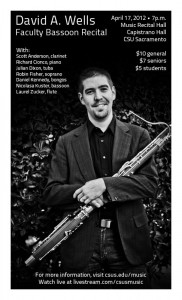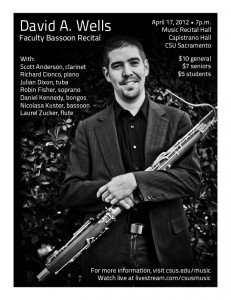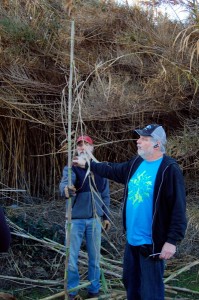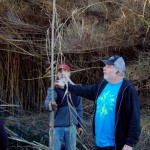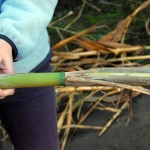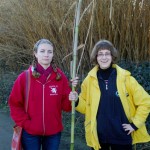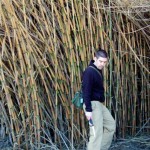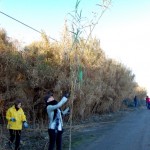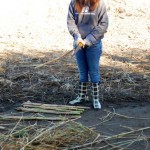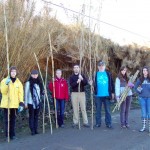
Sokiku Nakatani Tea Room
The library at Sacramento State boasts a feature which is, I believe, unique among American academic libraries: a Japanese tea room. The Sokiku Nakatani Tea Room, which was dedicated in 2007, was the gift of an anonymous donor and is named after a long-time Sacramento-area practitioner of Chado (more on this term soon). The tea room sits in the library’s basement, with windows looking out onto a small adjacent garden that is cleverly tucked away from the hustle and bustle above. In addition to housing a collection of tea ware and tea preparation utensils, the tea room periodically hosts tea ceremonies — more than twenty just this semester.
The room itself is small, but it has been cleverly constructed as a two-walled room-within-a-room to allow larger groups to participate in the ceremonies. Closed-circuit cameras and flat screen TVs even provide close-up views for those seated in the back rows. It just so happened that one of this semester’s tea ceremonies fell during our usual weekly reed/studio class time. I reserved spots for myself and my students and we took the week off from forming and scraping to learn about tea instead.
Our session began with Christie Bartlett of the San Francisco Urasenke Foundation explaining the history of the tea ceremony. Its origins are in China in the 8th century, but it spread to Japan in the 9th century and was refined and elevated to an art form in the 12th through 16th centuries. She also explained that the term Chanoyu (also Chado) is often translated as “tea ceremony,” but a more correct rendering in English is “the way of tea.” This reflects the influence of Zen Buddhism on its development — the ceremony itself has more to do with philosophy than mere procedure.
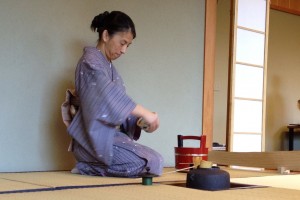
Our Host Preparing the Tea
Every aspect of the ceremony is highly formalized. The guests enter the tea room one-by-one, scooting in through the traditionally small door — everyone, no matter his or her social or political standing, must kneel to enter. The guests make two stops inside the room before settling down. The first is in front of the tokonoma, a small alcove in which are displayed a calligraphic scroll and a simple flower arrangement. The second is at the hearth, in which the tea water is heated. Once the guests are settled, the host enters, and the ceremony proper begins. Each person involved is responsible for doing or saying certain things, but the host and the first guest have the most involved roles. The host prepares the tea in a very precise, intentioned, and practiced way. Every motion is well thought out and efficient.
In the actions of the host (whose name I didn’t catch — sorry!) as she prepared the tea, I observed a number of qualities to which we should also aspire in playing the bassoon:
- Economy of Motion - Our host moved exactly as much as necessary to complete each action — no more, no less.
- Mindfulness and Focus - As she prepared the tea, our host gave her full attention to what she was doing. Narration and questions were handled by Ms. Bartlett. Our host did speak to us, but always in between batches of tea.
- Execution - It was very clear that our host was extremely practiced in her motions, and executed them exactly the same way for each of the four batches of tea she prepared.
Economy of finger motion is certainly essential to a fluid bassoon technique, and we should of course strive to always concentrate on what we are playing. But I think that the last of these qualities — precision of execution — has the most to teach us about performing. One action in particular impressed me quite a bit. At a certain point during the preparation of each bowl of tea, our host would use a small folded cloth to wipe the rim of a the tea bowl. Once she had done this, she would set the cloth (rather thick when folded) on the slanted lid of the tea pot, itself perched on top of a small cylinder (seen to the left of the kettle in the above photo). Even though the lid was sloped at a steep angle and was barely wider than the cloth, she never moved tentatively or had to make any adjustments to keep the cloth from falling off. She simply set it on its seemingly precarious perch and moved on.
To my way of thinking, this is exactly how we should perform a difficult musical passage — with intention, confidence, and plenty of preparation. We can’t gingerly approach the high C that opens Stravinsky’s Rite of Spring, nor can we stop to make adjustments to our reed or our fingering once we’ve started playing it. Our preparation has to be so good that we can simply place the C on its perch, just like the tea cloth, and then move on.
But beyond the actions involved in preparing tea, I believe that the philosophy of the ceremony has something to teach us musicians, as well. This lesson is nicely encapsulated by something Ms. Bartlett said after we had consumed our tea: “The tea ceremony is not about drinking green liquid.” That is, preparing and drinking tea is not the point. Rather, the way of tea is about people coming together to step away from the concerns of the world, appreciate the beauty of simple actions and ordinary things, and to talk with each other as equals about beauty, art, and the like.
I see in this a strong parallel to the ritual of rehearsing and performing in a musical ensemble. To paraphrase: “Playing in an orchestra is not about operating the bassoon.” Between reeds, fingerings, and difficult musical passages of all kinds, it’s easy to focus on the act of just making our instrument function. But our real purpose for being there is to connect with our fellow players and to make music. If we lose sight of this, we can’t ever reach our full potential as performers.
These are my initial impressions, but the ceremony gave me and my students plenty on which to ruminate. I think it’s very helpful to have a something completely outside the realm of music to use as a frame of reference for how we approach playing the bassoon. Because we had such a good time and got so much out of the experience, I think I’ll make attending a tea ceremony an annual CSUS Bassoon Studio event.
